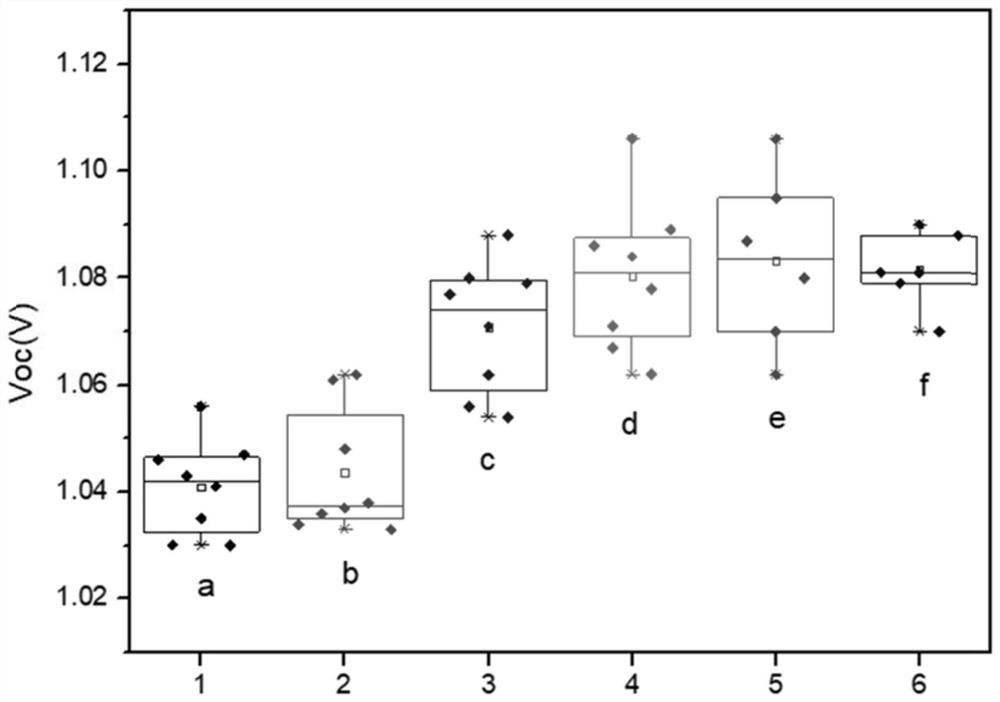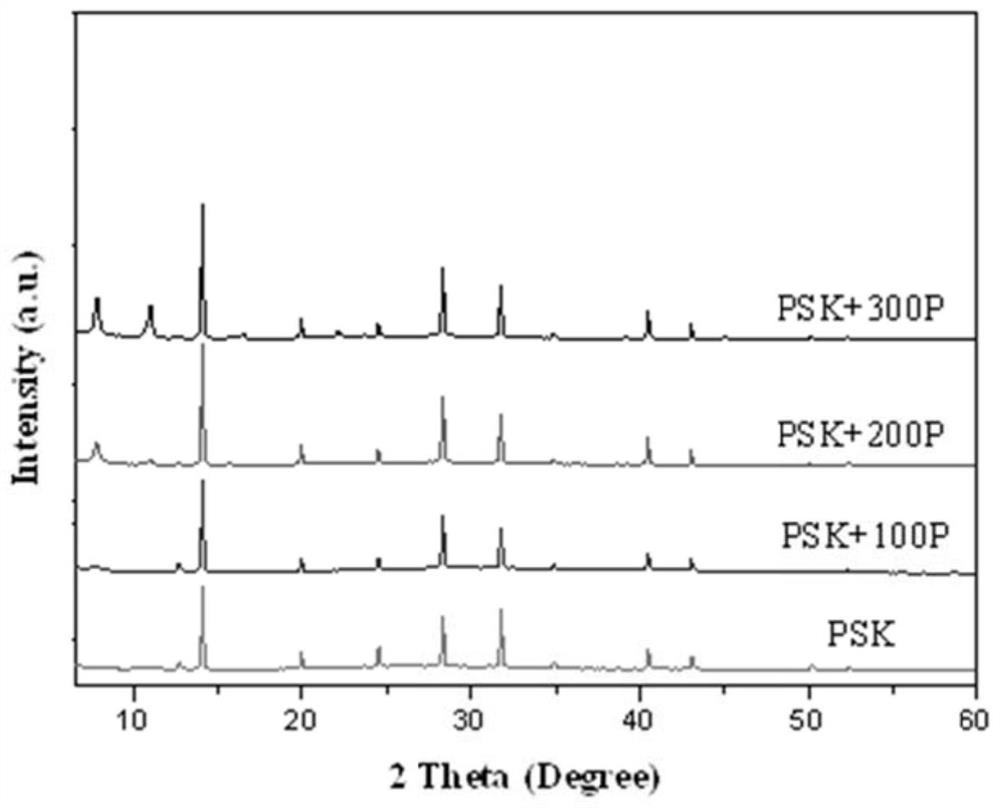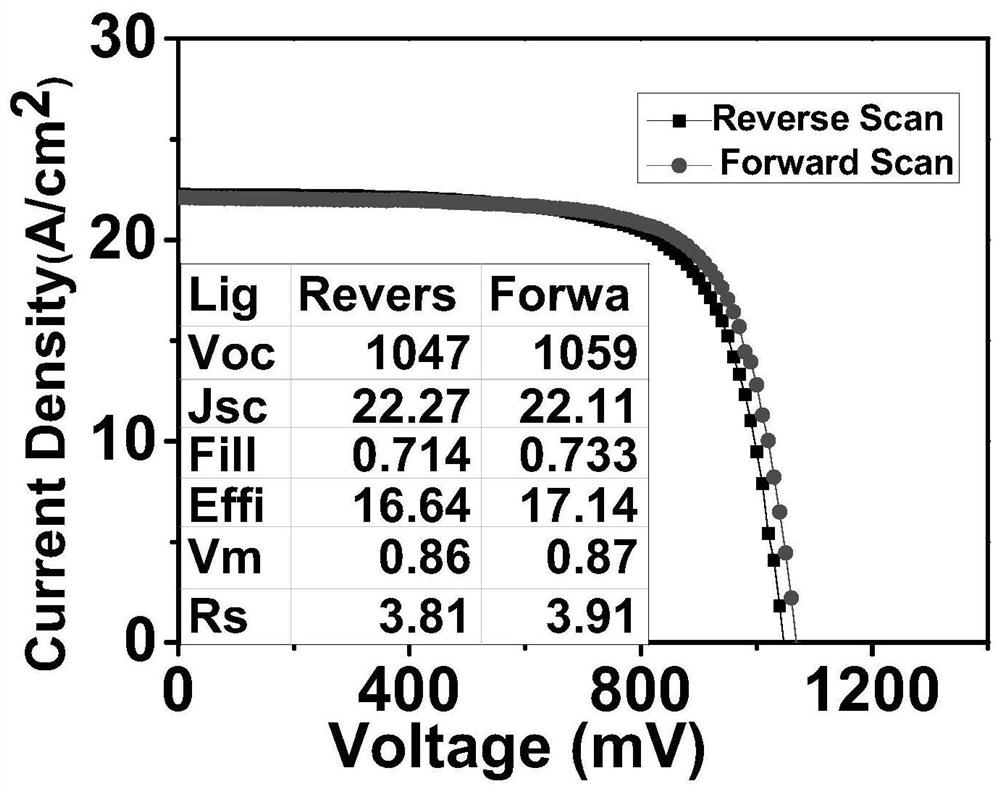A stable and efficient perovskite semiconductor thin film solar cell and its preparation method
A solar cell and perovskite technology, which is applied in semiconductor/solid-state device manufacturing, semiconductor devices, circuits, etc., can solve the problem that the oxidation defects of perovskite films have no obvious effect, overcome the lack of stability and promote hole transport. , the preparation method is simple
- Summary
- Abstract
- Description
- Claims
- Application Information
AI Technical Summary
Problems solved by technology
Method used
Image
Examples
Embodiment 1
[0036] The preparation of a perovskite semiconductor thin-film solar cell surface-modified with an organic phosphide specifically includes the following steps:
[0037] (1) Substrate pretreatment: Divide the FTO conductive glass into 10cm×10cm, ultrasonically clean it with detergent, deionized water, and ethanol three times, each time for 20 minutes, and finally dry it with nitrogen for use;
[0038] (2) Preparation of the hole transport layer: dissolving stannous chloride, urea, mercaptoacetic acid and concentrated hydrochloric acid in 400 ml of deionized water to form a tin oxide mother liquor of 12 millimoles per liter, and taking 30 milliliters of the mother liquor after two days in refrigeration Dilute it six times, use the soaking method, put the FTO conductive glass in the diluent, let it stand at 80°C for 5 hours, wash it with pure water, then dry it with nitrogen, and heat it from room temperature to 180°C in the last 30 minutes and keep it warm for two hours. The hol...
Embodiment 2
[0044] The preparation of a perovskite semiconductor thin-film solar cell surface-modified with an organic phosphide specifically includes the following steps:
[0045] (1) Substrate pretreatment: Divide the FTO conductive glass into 10cm×10cm, ultrasonically clean it with detergent, deionized water, and ethanol three times, each time for 20 minutes, and finally dry it with nitrogen for use;
[0046] (2) Preparation of the hole transport layer: dissolving stannous chloride, urea, mercaptoacetic acid and concentrated hydrochloric acid in 400 ml of deionized water to form a tin oxide mother liquor of 12 millimoles per liter, and taking 30 milliliters of the mother liquor after two days in refrigeration Dilute it six times, use the soaking method, put the FTO conductive glass in the diluent, let it stand at 80°C for 5 hours, then wash it with pure water, then blow it dry with nitrogen, and heat it from room temperature to 180°C within 30 minutes. The hole transport layer was prep...
Embodiment 3
[0052] The preparation of a perovskite semiconductor thin-film solar cell surface-modified with an organic phosphide specifically includes the following steps:
[0053] (1) Substrate pretreatment: Divide the FTO conductive glass into 10cm×10cm, ultrasonically clean it with detergent, deionized water, and ethanol three times, each time for 20 minutes, and finally dry it with nitrogen for use;
[0054] (2) Preparation of the hole transport layer: dissolving stannous chloride, urea, mercaptoacetic acid and concentrated hydrochloric acid in 400 ml of deionized water to form a tin oxide mother liquor of 12 millimoles per liter, and taking 30 milliliters of the mother liquor after two days in refrigeration Dilute it six times, use the soaking method, put the FTO conductive glass in the diluent, let it stand at 80°C for 5 hours, wash it with pure water, then dry it with nitrogen, and heat it from room temperature to 180°C in the last 30 minutes and keep it warm for two hours. The hol...
PUM
 Login to View More
Login to View More Abstract
Description
Claims
Application Information
 Login to View More
Login to View More - R&D
- Intellectual Property
- Life Sciences
- Materials
- Tech Scout
- Unparalleled Data Quality
- Higher Quality Content
- 60% Fewer Hallucinations
Browse by: Latest US Patents, China's latest patents, Technical Efficacy Thesaurus, Application Domain, Technology Topic, Popular Technical Reports.
© 2025 PatSnap. All rights reserved.Legal|Privacy policy|Modern Slavery Act Transparency Statement|Sitemap|About US| Contact US: help@patsnap.com



